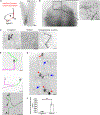Trigeminal innervation and tactile responses in mouse tongue
- PMID: 39215998
- PMCID: PMC11500437
- DOI: 10.1016/j.celrep.2024.114665
Trigeminal innervation and tactile responses in mouse tongue
Abstract
The neural basis of tongue mechanosensation remains largely mysterious despite the tongue's high tactile acuity, sensitivity, and relevance to ethologically important functions. We studied terminal morphologies and tactile responses of lingual afferents from the trigeminal ganglion. Fungiform papillae, the taste-bud-holding structures in the tongue, were convergently innervated by multiple Piezo2+ trigeminal afferents, whereas single trigeminal afferents branched into multiple adjacent filiform papillae. In vivo single-unit recordings from the trigeminal ganglion revealed lingual low-threshold mechanoreceptors (LTMRs) with distinct tactile properties ranging from intermediately adapting (IA) to rapidly adapting (RA). The receptive fields of these LTMRs were mostly less than 0.1 mm2 and concentrated at the tip of the tongue, resembling the distribution of fungiform papillae. Our results indicate that fungiform papillae are mechanosensory structures and suggest a simple model that links functional and anatomical properties of tactile sensory neurons in the tongue.
Keywords: CP: Neuroscience; LTMR; mechanoreceptor; somatosensation; taste bud; tongue; touch; trigeminal; trigeminal ganglion.
Copyright © 2024 The Author(s). Published by Elsevier Inc. All rights reserved.
Conflict of interest statement
Declaration of interests The authors declare no competing interests.
Figures







Update of
-
Trigeminal innervation and tactile responses in mouse tongue.bioRxiv [Preprint]. 2024 May 13:2023.08.17.553449. doi: 10.1101/2023.08.17.553449. bioRxiv. 2024. Update in: Cell Rep. 2024 Sep 24;43(9):114665. doi: 10.1016/j.celrep.2024.114665. PMID: 37645855 Free PMC article. Updated. Preprint.
References
-
- Tei K, Yamazaki Y, Kobayashi M, Izumiyama Y, Ono M, and Totsuka Y (2004). Effects of bilateral lingual and inferior alveolar nerve anesthesia effects on masticatory function and early swallowing. Oral Surg. Oral Med. Oral Pathol. Oral Radiol. Endod. 97, 553–558. 10.1016/S1079210403006875. - DOI - PubMed
MeSH terms
Grants and funding
LinkOut - more resources
Full Text Sources
Molecular Biology Databases
Miscellaneous

